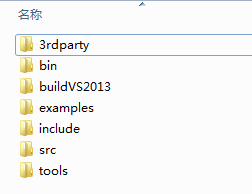本文假设你已经安装CUDA,CUDA版本是7.5。
1.编译caffe的Windows版本
happynear的博客已经介绍了如何在windows下编译caffe,这里把我自己编译的过程记录下来,也算是做做笔记,方便以后查看。
1.1下载caffe-windows-master
下载地址:
caffe-windows-master
1.2下载第三方库
下载地址:
3rdparty
1.3 解压
解压第三方库3rdparty,解压到caffe-windows-master中的3rdparty文件夹中,即caffe-windows-master/3rdparty中的内容为:

!!!然后,需要将bin文件夹加入环境变量中。
当然,如果嫌麻烦,下载我解压好的文件就行,跳过以上过程,下载该文件,下载地址:
点击这里。
1.4 开始编译
双击caffe-windows-master\src\caffe\proto\extract_proto.bat,生成
caffe.pb.h和caffe.pb.cc两个c++文件,和caffe_pb2.py这个python使用的文件。然后,用vs2013打开./buildVS2013/MainBuilder.sln,打开之后切换编译模式至Release X64模式。如果你的CUDA版本不是7.5,打开之后可能显示加载失败,这时就要用记事本打开./buildVS2013/MSVC/MainBuilder.vcxproj,搜索CUDA 7.5,把这个7.5换成你自己的CUDA版本,就可以正常打开了。
右键caffelib项目,配置属性——>常规,将配置类型修改为应用程序(.exe),目标文件扩展名修改为.exe;接着:
C/C++ ——> 常规,附加包含目录修改如下(CUDA路径按自己的修改):
../../3rdparty/include
../../src
../../include
C:\Program Files\NVIDIA GPU Computing Toolkit\CUDA\v7.5\include
../../3rdparty/libC:\Program Files\NVIDIA GPU Computing Toolkit\CUDA\v7.5\lib\x64
链接器——>输入;将cudnn64_65.lib修改成cudnn.lib
Matcaffe项目:
附加包含目录:
../../3rdparty/include
../../src
../../include
C:\Program Files\NVIDIA GPU Computing Toolkit\CUDA\v7.5\include
D:\Program Files\MATLAB\R2014a\extern\include
附加库目录:
../../3rdparty/lib
C:\Program Files\NVIDIA GPU Computing Toolkit\CUDA\v7.5\lib\x64
D:\Program Files\MATLAB\R2014a\extern\lib\win64\microsoft
Pycaffe项目:
附加包含目录:
../../3rdparty/include
../../src
../../include
C:\Program Files\NVIDIA GPU Computing Toolkit\CUDA\v7.5\include
D:\Python27\include
D:\Python27\Lib\site-packages\numpy\core\include
附加库目录:
../../3rdparty/lib
C:\Program Files\NVIDIA GPU Computing Toolkit\CUDA\v7.5\lib\x64
D:\Python27\libs2.修改classification.cpp代码
右键caffelib,添加新建项classification.cpp,classification.cpp代码可参考如下:
该代码逐张读取文件夹下的图像并将分类结果显示在图像左上角,空格下一张。
结果显示在左上角,有英文和中文两种标签可选,如果显示中文,需要使用Freetype库,请自行百度。


最后,可以删除那些不需要的文件或文件夹,如我的caffe-windows-master内只留下:
#include <caffe/caffe.hpp>
#include <opencv2/core/core.hpp>
#include <opencv2/highgui/highgui.hpp>
#include <opencv2/imgproc/imgproc.hpp>
#include <iosfwd>
#include <memory>
#include <utility>
#include <vector>
#include <iostream>
#include <string>
#include <sstream>
#include "CvxText.h" //英文标签去掉该头文件
using namespace caffe; // NOLINT(build/namespaces)
using std::string;
/* Pair (label, confidence) representing a prediction. */
typedef std::pair<string, float> Prediction;
class Classifier {
public:
Classifier(const string& model_file,
const string& trained_file,
const string& mean_file,
const string& label_file);
std::vector<Prediction> Classify(const cv::Mat& img, int N = 5);
private:
void SetMean(const string& mean_file);
std::vector<float> Predict(const cv::Mat& img);
void WrapInputLayer(std::vector<cv::Mat>* input_channels);
void Preprocess(const cv::Mat& img,
std::vector<cv::Mat>* input_channels);
private:
shared_ptr<Net<float> > net_;
cv::Size input_geometry_;
int num_channels_;
cv::Mat mean_;
std::vector<string> labels_;
};
Classifier::Classifier(const string& model_file,
const string& trained_file,
const string& mean_file,
const string& label_file) {
#ifdef CPU_ONLY
Caffe::set_mode(Caffe::CPU);
#else
Caffe::set_mode(Caffe::GPU);
#endif
/* Load the network. */
net_.reset(new Net<float>(model_file, TEST));
net_->CopyTrainedLayersFrom(trained_file);
CHECK_EQ(net_->num_inputs(), 1) << "Network should have exactly one input.";
CHECK_EQ(net_->num_outputs(), 1) << "Network should have exactly one output.";
Blob<float>* input_layer = net_->input_blobs()[0];
num_channels_ = input_layer->channels();
CHECK(num_channels_ == 3 || num_channels_ == 1)
<< "Input layer should have 1 or 3 channels.";
input_geometry_ = cv::Size(input_layer->width(), input_layer->height());
/* Load the binaryproto mean file. */
SetMean(mean_file);
/* Load labels. */
std::ifstream labels(label_file);
CHECK(labels) << "Unable to open labels file " << label_file;
string line;
while (std::getline(labels, line))
labels_.push_back(string(line));
Blob<float>* output_layer = net_->output_blobs()[0];
CHECK_EQ(labels_.size(), output_layer->channels())
<< "Number of labels is different from the output layer dimension.";
}
static bool PairCompare(const std::pair<float, int>& lhs,
const std::pair<float, int>& rhs) {
return lhs.first > rhs.first;
}
/* Return the indices of the top N values of vector v. */
static std::vector<int> Argmax(const std::vector<float>& v, int N) {
std::vector<std::pair<float, int> > pairs;
for (size_t i = 0; i < v.size(); ++i)
pairs.push_back(std::make_pair(v[i], i));
std::partial_sort(pairs.begin(), pairs.begin() + N, pairs.end(), PairCompare);
std::vector<int> result;
for (int i = 0; i < N; ++i)
result.push_back(pairs[i].second);
return result;
}
/* Return the top N predictions. */
std::vector<Prediction> Classifier::Classify(const cv::Mat& img, int N) {
std::vector<float> output = Predict(img);
std::vector<int> maxN = Argmax(output, N);
std::vector<Prediction> predictions;
for (int i = 0; i < N; ++i) {
int idx = maxN[i];
predictions.push_back(std::make_pair(labels_[idx], output[idx]));
}
return predictions;
}
/* Load the mean file in binaryproto format. */
void Classifier::SetMean(const string& mean_file) {
BlobProto blob_proto;
ReadProtoFromBinaryFileOrDie(mean_file.c_str(), &blob_proto);
/* Convert from BlobProto to Blob<float> */
Blob<float> mean_blob;
mean_blob.FromProto(blob_proto);
CHECK_EQ(mean_blob.channels(), num_channels_)
<< "Number of channels of mean file doesn't match input layer.";
/* The format of the mean file is planar 32-bit float BGR or grayscale. */
std::vector<cv::Mat> channels;
float* data = mean_blob.mutable_cpu_data();
for (int i = 0; i < num_channels_; ++i) {
/* Extract an individual channel. */
cv::Mat channel(mean_blob.height(), mean_blob.width(), CV_32FC1, data);
channels.push_back(channel);
data += mean_blob.height() * mean_blob.width();
}
/* Merge the separate channels into a single image. */
cv::Mat mean;
cv::merge(channels, mean);
/* Compute the global mean pixel value and create a mean image
* filled with this value. */
cv::Scalar channel_mean = cv::mean(mean);
mean_ = cv::Mat(input_geometry_, mean.type(), channel_mean);
}
std::vector<float> Classifier::Predict(const cv::Mat& img) {
Blob<float>* input_layer = net_->input_blobs()[0];
input_layer->Reshape(1, num_channels_,
input_geometry_.height, input_geometry_.width);
/* Forward dimension change to all layers. */
net_->Reshape();
std::vector<cv::Mat> input_channels;
WrapInputLayer(&input_channels);
Preprocess(img, &input_channels);
net_->ForwardPrefilled();
/* Copy the output layer to a std::vector */
Blob<float>* output_layer = net_->output_blobs()[0];
const float* begin = output_layer->cpu_data();
const float* end = begin + output_layer->channels();
return std::vector<float>(begin, end);
}
/* Wrap the input layer of the network in separate cv::Mat objects
* (one per channel). This way we save one memcpy operation and we
* don't need to rely on cudaMemcpy2D. The last preprocessing
* operation will write the separate channels directly to the input
* layer. */
void Classifier::WrapInputLayer(std::vector<cv::Mat>* input_channels) {
Blob<float>* input_layer = net_->input_blobs()[0];
int width = input_layer->width();
int height = input_layer->height();
float* input_data = input_layer->mutable_cpu_data();
for (int i = 0; i < input_layer->channels(); ++i) {
cv::Mat channel(height, width, CV_32FC1, input_data);
input_channels->push_back(channel);
input_data += width * height;
}
}
void Classifier::Preprocess(const cv::Mat& img,
std::vector<cv::Mat>* input_channels) {
/* Convert the input image to the input image format of the network. */
cv::Mat sample;
if (img.channels() == 3 && num_channels_ == 1)
cv::cvtColor(img, sample, CV_BGR2GRAY);
else if (img.channels() == 4 && num_channels_ == 1)
cv::cvtColor(img, sample, CV_BGRA2GRAY);
else if (img.channels() == 4 && num_channels_ == 3)
cv::cvtColor(img, sample, CV_BGRA2BGR);
else if (img.channels() == 1 && num_channels_ == 3)
cv::cvtColor(img, sample, CV_GRAY2BGR);
else
sample = img;
cv::Mat sample_resized;
if (sample.size() != input_geometry_)
cv::resize(sample, sample_resized, input_geometry_);
else
sample_resized = sample;
cv::Mat sample_float;
if (num_channels_ == 3)
sample_resized.convertTo(sample_float, CV_32FC3);
else
sample_resized.convertTo(sample_float, CV_32FC1);
cv::Mat sample_normalized;
cv::subtract(sample_float, mean_, sample_normalized);
/* This operation will write the separate BGR planes directly to the
* input layer of the network because it is wrapped by the cv::Mat
* objects in input_channels. */
cv::split(sample_normalized, *input_channels);
CHECK(reinterpret_cast<float*>(input_channels->at(0).data)
== net_->input_blobs()[0]->cpu_data())
<< "Input channels are not wrapping the input layer of the network.";
}
//获取路径path下的文件,并保存在files容器中
void getFiles(string path, vector<string>& files)
{
//文件句柄
long hFile = 0;
//文件信息
struct _finddata_t fileinfo;
string p;
if ((hFile = _findfirst(p.assign(path).append("\\*").c_str(), &fileinfo)) != -1)
{
do
{
if ((fileinfo.attrib & _A_SUBDIR))
{
if (strcmp(fileinfo.name, ".") != 0 && strcmp(fileinfo.name, "..") != 0)
getFiles(p.assign(path).append("\\").append(fileinfo.name), files);
}
else
{
files.push_back(p.assign(path).append("\\").append(fileinfo.name));
}
} while (_findnext(hFile, &fileinfo) == 0);
_findclose(hFile);
}
}
int main(int argc, char** argv) {
//caffe的准备工作
#ifdef _MSC_VER
#pragma comment( linker, "/subsystem:\"windows\" /entry:\"mainCRTStartup\"" )
#endif
//::google::InitGoogleLogging(argv[0]);
string model_file("../../model/deploy.prototxt");
string trained_file("../../model/type.caffemodel");
string mean_file("../../model/type_mean.binaryproto");
string label_file("../../model/labels.txt");
string picture_path("../../type");
Classifier classifier(model_file, trained_file, mean_file, label_file);
vector<string> files;
getFiles(picture_path, files);
for (int i = 0; i < files.size(); i++)
{
cv::Mat img = cv::imread(files[i], -1);
cv::Mat img2;
std::vector<Prediction> predictions = classifier.Classify(img);
Prediction p = predictions[0];
CvSize sz;
sz.width = img.cols;
sz.height = img.rows;
float scal = 0;
scal = sz.width > sz.height ? (300.0 / (float)sz.height) : (300.0 / (float)sz.width);
sz.width *= scal;
sz.height *= scal;
resize(img, img2, sz, 0, 0, CV_INTER_LINEAR);
IplImage* show = cvCreateImage(sz, IPL_DEPTH_8U, 3);
string text = p.first;
char buff[20];
_gcvt(p.second, 4, buff);
text = text + ":" + buff;
/************************输出中文(用到Freetype库)****************************/
/*CvxText mytext("../../STZHONGS.TTF");// 字体文件
const char *msg = text.c_str();
CvScalar size;
size.val[0] = 26;
size.val[1] = 0.5;
size.val[2] = 0.1;
size.val[3] = 0;
mytext.setFont(NULL,&size, NULL, NULL); // 设置字体大小
mytext.putText(&IplImage(img2), msg, cvPoint(10, 30), cvScalar(0, 0, 255, NULL));
//输出图像名
text = files[i].substr(files[i].find_last_of("\\")+1);
msg = text.c_str();
mytext.putText(&IplImage(img2), msg, cvPoint(10, 55), cvScalar(0, 0, 255, NULL));
cvCopy(&(IplImage)img2, show);*/
/*******************************************************************************/
/***************************输出英文标签*****************************************/
cvCopy(&(IplImage)img2, show);
CvFont font;
cvInitFont(&font, CV_FONT_HERSHEY_COMPLEX, 1.0, 1.0, 0, 2, 8); //初始化字体
cvPutText(show, text.c_str(), cvPoint(10, 30), &font, cvScalar(0, 0, 255, NULL));
text = files[i].substr(files[i].find_last_of("\\")+1);
cvPutText(show, text.c_str(), cvPoint(10, 55), &font, cvScalar(0, 0, 255, NULL));
/**********************************************************************************/
cvNamedWindow("结果展示");
cvShowImage("结果展示", show);
int c = cvWaitKey();
cvDestroyWindow("结果展示");
cvReleaseImage(&show);
if (c == 27)
{
return 0;
}
}
return 0;
}
3.生成
设置好之后,右键caffelib,生成。
4.结果
左边是中文标签,右边是英文标签。


也可以下载我封装好的代码,可通过链接下载:http://download.csdn.net/detail/sinat_30071459/9568131 是一个txt文件,因为csdn上传限制,代码上传到了百度云,txt里面有百度云链接。下载解压后将Classification\CLassificationDLL\bin加入环境变量,然后加入你的模型文件即可。








 本文详细介绍如何在Windows环境下编译Caffe及其依赖库,并提供了一个示例程序用于图像分类任务。
本文详细介绍如何在Windows环境下编译Caffe及其依赖库,并提供了一个示例程序用于图像分类任务。

















 1294
1294

 被折叠的 条评论
为什么被折叠?
被折叠的 条评论
为什么被折叠?








